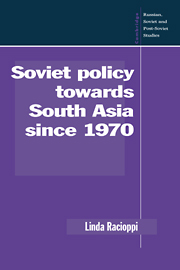Book contents
- Frontmatter
- Contents
- List of tables
- Acknowledgments
- 1 Introduction: South Asia in the USSR's Third World policy
- 2 Soviet perceptions of the Third World and South Asia
- 3 The Soviet Union in South Asia: objectives and instruments
- 4 Stability and change in Soviet–South Asian relations, 1970–1978
- 5 Soviet–South Asian relations in the wake of Afghanistan, 1978–1985
- 6 Soviet Policy towards South Asia in the Gorbachev era
- 7 Conclusion
- Notes
- Index
- Soviet and East European Studies
6 - Soviet Policy towards South Asia in the Gorbachev era
Published online by Cambridge University Press: 15 December 2009
- Frontmatter
- Contents
- List of tables
- Acknowledgments
- 1 Introduction: South Asia in the USSR's Third World policy
- 2 Soviet perceptions of the Third World and South Asia
- 3 The Soviet Union in South Asia: objectives and instruments
- 4 Stability and change in Soviet–South Asian relations, 1970–1978
- 5 Soviet–South Asian relations in the wake of Afghanistan, 1978–1985
- 6 Soviet Policy towards South Asia in the Gorbachev era
- 7 Conclusion
- Notes
- Index
- Soviet and East European Studies
Summary
Introduction
When Mikhail Sergeevich Gorbachev was elected General Secretary of the Communist Party of the Soviet Union in 1985, few observers expected the kind of far-reaching reform of Soviet foreign policy which would be manifested in the next five years. The introduction of perestroika, however, necessitated rethinking of Soviet international relations as well. Perestroika made it difficult, if not impossible, to de-link foreign policy from domestic politics: if there were to be reform of the Soviet economy, foreign affairs would have to be put at the service of domestic economic and political requirements. Improved international stature, renewed detente with the West and rapprochement with China were seen as essential for the success of domestic restructuring; without these, cutbacks in military spending would be inconceivable, and without changes in spending priorities, reform would be unworkable. Thus, the New Thinking in Soviet foreign policy promoted interdependence, deideologization of interstate relations, global security, and negotiated ends to regional conflicts. One of the most devastating conflicts in the Third World was one the USSR had helped foster: Afghanistan. In order to improve relations particularly with China but also with the West, the USSR had to resolve the problem of their military intervention. Also importantly, if the theoretical underpinnings of the New Thinking were to be carried forward, Afghanistan would have to be dealt with.
- Type
- Chapter
- Information
- Soviet Policy towards South Asia since 1970 , pp. 148 - 177Publisher: Cambridge University PressPrint publication year: 1994



